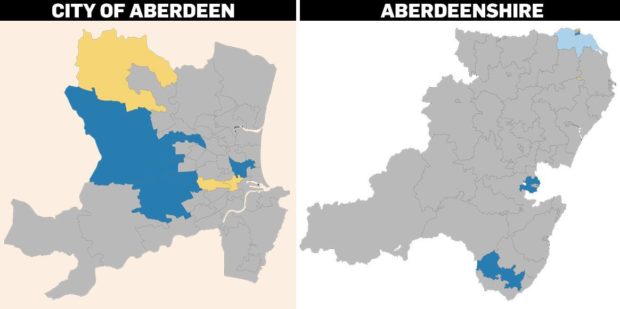More than half of the areas in Aberdeen and Aberdeenshire have an infection rate of more than 200 cases per 100,000 population, according to the latest figures.
The official statistics show the spread of coronavirus across the north-east and give an idea of how your community is affected.
Each area of the country has been divided into regions of roughly similar populations, and are the same used in a wide range of national datasets released by the Scottish Government.
The latest figures, released on January 5, shows Covid-19 cases from December 27 to January 2.
That number can also be put into context – by saying how many cases there have been per 100,000 population.
To help visualise this, the rate is categorised into one of five bands, or if the number of cases in the seven-day period is two or less, it is marked as suppressed.
What’s the picture like Scotland wide?
The Scotland-wide seven-day positive rate per 100,000 population is 279.7, with 15,280 people testing positive during this period.
Of all the tests carried out, 11.8% of test returned a positive result.
The areas of the country with the highest positivity rate include North Lanarkshire, Renfrewshire, Dumfries & Galloway, Scottish Borders and Inverclyde.
Aberdeen
Aberdeen has an average rate per 100,000 population of 277.3 up from 164.9 during the previous seven-day period
Over 630 positive cases of Covid-19 were identified during this period, an increase of 68.2% (257) on the previous period.
Of all the tests carried out in the region, 12.1% were positive.
Seven neighbourhoods in Aberdeen are in the highest category, with a rate greater than 400 per 100,000 people.
Cults, Bieldside and Milltimber West, Hazlehead, Kincorth, Leggart and Nigg South, Midstocket, Oldmachar West, Torry East and West End North are all in this band.
Of Aberdeen’s 49 zones, 33 have a rate of more than 200 cases per 100,000
No areas of the city are in the lowest of category, and no area has their figures suppressed for the last seven days.
Aberdeenshire
In Aberdeenshire, there have been 677 cases in the last seven-day period, with a positive rate of 259.2 per 100,000 – below that of the Scottish average.
The test positivity rate for the region, however, is above the national average at 12.7%
Twelve areas of Aberdeenshire are in the highest category, with more than 400 cases per 100,000 population. These include large parts of the west of the region, as well as neighbourhoods to the north of the city.
A further 18 areas are in the second-highest band, with cases ranging between 200 and 399 per 100,000 population.
Unlike Aberdeen, a number of areas in Aberdeenshire have had their data suppressed.
These include two neighbourhoods in Fraserburgh, as well as Mintlaw and Turriff.
https://www.eveningexpress.co.uk/fp/news/specials/coronavirus-in-scotland-track-the-spread-in-these-charts-and-maps3010/
